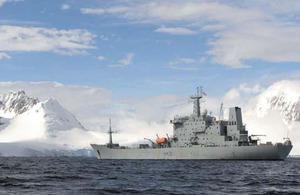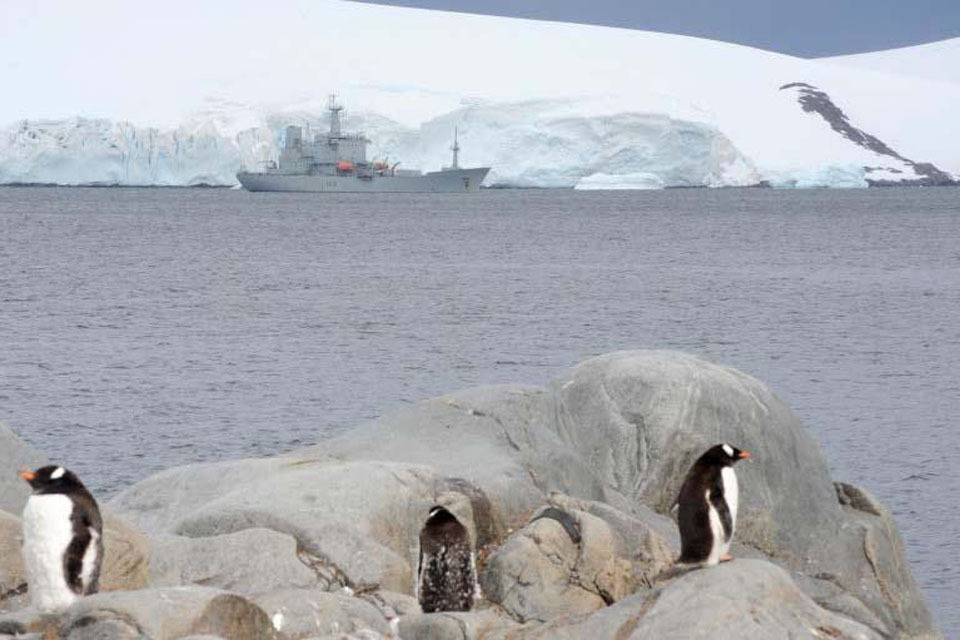HMS Scott returns from the Antarctic
The Royal Navy's ocean survey vessel HMS Scott is hoping for a warm welcome on her return to Devonport on Sunday 10 April 2011, after travelling over 22,500 miles (36,000km) through one of the most austere maritime environments on the planet.

HMS Scott anchored in Neumayer Channel, Antarctica [Picture: POA(Phot) Ray Jones, Crown Copyright/MOD 2011]
The ship left her home port last November and has now completed her second deployment to Antarctica. HMS Scott has spent the austral summer working on behalf of the British Foreign and Commonwealth Office, the British Antarctic Survey and the United Kingdom Hydrographic Office.
The ship’s tasks have included inspecting Antarctic research stations and unique areas of scientific interest, enforcing and observing the stringent environmental protective measures of the Antarctic Treaty.
This helps to ensure that the pristine nature of Antarctica is maintained for generations to come. HMS Scott has also used her state-of-the art sonar equipment to map the Antarctic seas to ensure safe passage for the plethora of cruise ships that are now visiting the region.
Thanks to the good weather and the use of smaller boats, the ship has been able to conduct visits to the bases of thirteen different nations, significantly more than in previous years.
Each visit allowed the ship’s company to see how different nationalities cope with life in the ‘deep freeze’. A common thread was the importance of food; from Chinese delicacies at their Great Wall Station, to afternoon tea and cakes at the British base at Rothera, Scott’s sailors were lucky to sample food from all over the globe. The Commanding Officer of HMS Scott, Commander George Tabeart, said:
The ice patrol ship deployment is a privileged step change from HMS Scott’s usual tasking of ocean survey. The capabilities of the ship allow a variety of alternative activities that are complementary to the work that has been previously undertaken by HMS Endurance and will be undertaken by HMS Protector.
With safety of life paramount in these remote waters, our survey work will ensure that tourists can safely visit the pristine environment and witness the abundance of wildlife.

Gentoo penguins look on during HMS Scott's visit to Port Lockroy, Antarctica [Picture: POA(Phot) Ray Jones, Crown Copyright/MOD 2011]
HMS Scott’s deployment to the South Atlantic has been in support of the UK’s long-term strategic, scientific, environmental and sustainable resource management interests in the Antarctic, South Georgia, the South Sandwich Islands, and the wider area.
The UK protects these interests, and the nation’s sovereignty, by taking a leading role in the Antarctic Treaty system through a policy of presence, governance and commitment to deliver the UK’s international obligations. The ship is due to undergo a short maintenance period on her return to Devonport before returning to her deep-water ocean survey duties.
Commissioned in 1997, HMS Scott is the fifth largest vessel in the fleet at 13,500 tons (12,250 metric tonnes). Her size is a consequence of her unique sonar fit, capable of surveying the deepest oceans in continuous lines of up to 400 miles (640km) in length.
The full ship’s crew is 78, but the crew rotation system means 52 are onboard at any one time during a standard 35-day operational cycle, with the remainder of the crew taking leave.
By operating in such a manner the ship maximises its operational availability and effectiveness by being at sea for 307 days per year.
The Royal Navy has recently announced the procurement of HMS Protector, a Norwegian ice patrol ship, which will initially be leased for three years. The ship’s mission will be to patrol and survey the Antarctic and South Atlantic while the long-term future of HMS Endurance is considered.